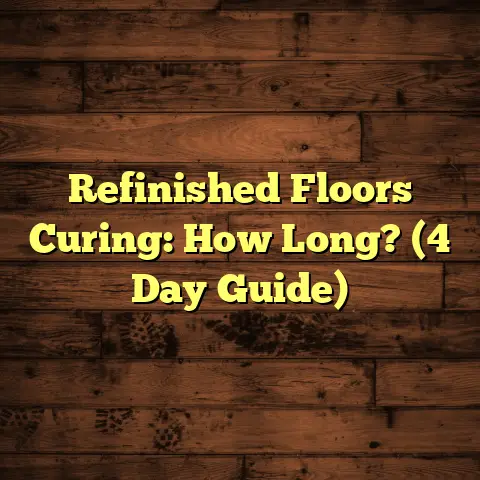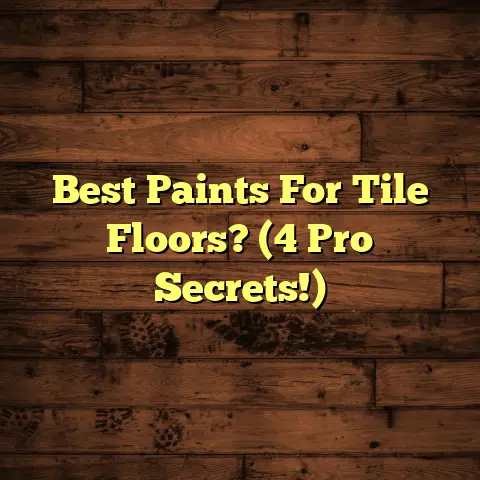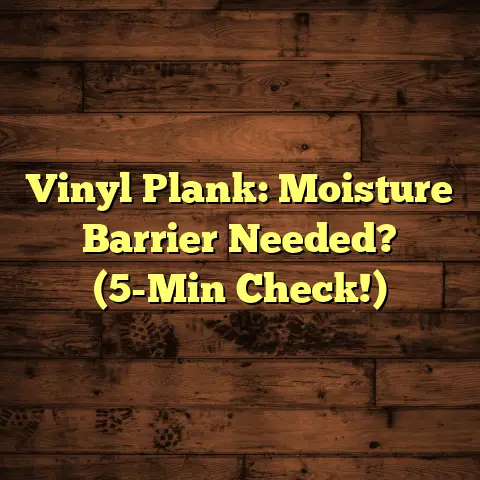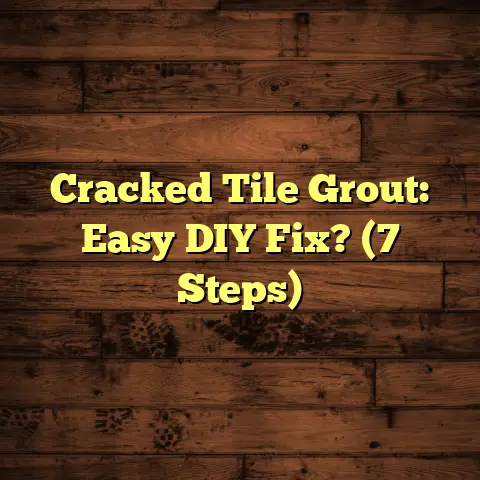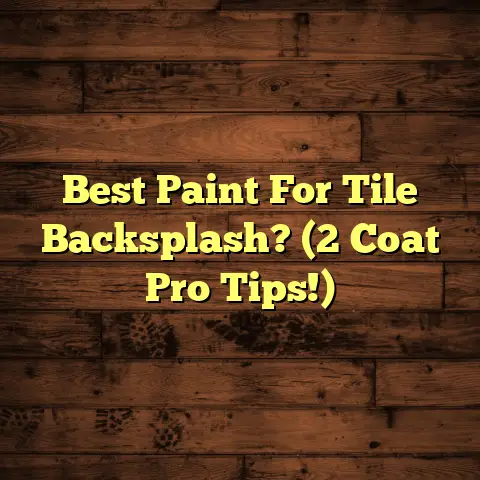How Do You Clean Wood Floors Without Streaks? (Explained)
Cleaning wood floors without leaving streaks can feel like trying to find a unicorn in your backyard. You know it exists, but somehow, it always seems just out of reach! I’ve been there—spending hours on my hands and knees only to stand up and see a shiny mess instead of the gleaming floor I envisioned. It’s both frustrating and humorous, especially when you realize that the secret to a streak-free finish is often simpler than we make it out to be.
The Quest for Streak-Free Floors
When I first started out as a flooring contractor, I had my share of cleaning mishaps. I remember one particular job where I cleaned a beautiful oak floor, only to have the homeowner call me back the next day. “Mizanul, it looks worse than when you started!” she exclaimed. My heart sank, but it was a valuable lesson learned.
Over the years, I’ve experimented with various cleaning methods and products—some successful, some not so much. The good news is that I’ve compiled my best tips and techniques to help you achieve that sought-after streak-free shine!
Choose the Right Tools
The first step in achieving streak-free wood floors is to use the right tools. Here’s what I recommend based on personal experience:
- Microfiber Mop: This is a game-changer. Unlike traditional mops, microfiber mops lift dirt without leaving any residue. Plus, they’re lightweight and easy to maneuver.
- Broom and Dustpan: Before mopping, always sweep or vacuum to remove dust and debris. I’ve learned the hard way that skipping this step leads to dirt smudges.
- Bucket: A sturdy bucket is essential for mixing your cleaning solution. Just make sure it’s clean—using a dirty bucket can undo all your hard work!
Selecting the Right Cleaning Solution
Now that you have your tools, let’s talk about cleaning solutions. I’ve tried a variety of products over the years, and here’s what works best:
- Homemade Solution: A mixture of 1 cup of white vinegar in 1 gallon of warm water works wonders. Vinegar cuts through grime without leaving streaks. Just be cautious using it on waxed floors, as it can strip the wax.
- Commercial Cleaners: If you prefer store-bought solutions, look for pH-neutral cleaners specifically designed for wood floors. I once used an all-purpose cleaner that promised a streak-free shine but ended up with more streaks than I could count!
The Cleaning Process
Let’s get down to business! Here’s how I clean wood floors step-by-step:
- Preparation: Sweep or vacuum the floor thoroughly. Make sure to pay attention to corners and under furniture—dust loves to hide!
- Mix Your Solution: If you’re using the vinegar method, mix it with warm water in your bucket. If you’re using a commercial cleaner, follow the instructions on the bottle.
- Mopping Technique: Dip your microfiber mop into the solution, wring it out well (it should be damp, not soaking), and start mopping in sections. I usually start in the farthest corner of the room and work my way towards the exit—this way, I don’t accidentally step on freshly cleaned areas.
- Rinse and Repeat: After mopping a section, rinse your mop in clean water, wring it out again, and continue. This prevents dirt from being spread around.
- Drying: Allow the floor to air dry completely before walking on it. If you’re in a hurry, you can use a dry microfiber cloth to speed up the drying process.
Dealing with Stubborn Stains
Sometimes, despite our best efforts, stubborn stains pop up like uninvited guests at a party. Here are some tips based on my experiences:
- Water Rings: For water rings caused by cups or plants, try rubbing a little olive oil on the area with a soft cloth. It often does the trick!
- Scuff Marks: Crayons or shoe scuffs can be removed with a bit of baking soda on a damp cloth. Just rub gently so you don’t scratch the finish.
- Sticky Residue: For sticky spots (like spilled drinks), avoid harsh chemicals. Instead, mix equal parts of vinegar and water and gently rub with a cloth.
The Role of FloorTally in Estimation
As a flooring contractor, I often have to provide estimates for cleaning and maintenance tasks along with installation work. This is where FloorTally comes into play. It helps me accurately calculate costs related to cleaning materials based on the size of the space and specific needs.
For example, if I’m working on a 1,000 square foot home with hardwood floors needing a deep clean, I can input various factors into FloorTally—like local material costs and labor rates—to generate an accurate estimate. This allows me to provide clients with transparent pricing and helps build trust.
Common Mistakes to Avoid
Through my journey as a flooring contractor, I’ve encountered some common mistakes that many people make when cleaning wood floors:
- Using Too Much Water: Wood is sensitive to moisture; too much water can lead to warping or damage over time. Always wring out your mop thoroughly.
- Ignoring Manufacturer’s Instructions: Each type of wood floor might have specific care instructions from the manufacturer. Always read these before proceeding with any cleaning methods.
- Using Harsh Chemicals: Many people think that stronger is better, but harsh chemicals can damage finishes and leave behind residues that attract dirt.
Tips for Maintenance Between Deep Cleans
Keeping your wood floors looking pristine is not just about deep cleaning; regular maintenance plays a vital role too! Here are some strategies I’ve found effective:
- Regular Sweeping or Vacuuming: Keeping dust and dirt at bay is crucial. I usually set aside 10-15 minutes every couple of days to sweep or vacuum high-traffic areas.
- Using Floor Mats: Placing mats at entryways can help trap dirt before it gets tracked onto your floors. Trust me; this one small change can make a big difference!
- Avoiding Shoes Indoors: If you really want to keep your wood floors in top shape, consider adopting a no-shoes policy inside your home. It might sound drastic, but it significantly reduces wear and tear.
Seasonal Cleaning Considerations
Changing seasons bring different challenges for wood floor maintenance. During winter, for example, salt and snow can wreak havoc on hardwood floors. Here’s how I tackle seasonal cleaning:
- In winter months, I’ll often put down mats near entrances to catch snow and salt before it reaches the floors.
- After every snowstorm, I make sure to wipe any salt residue from shoes immediately—before it has a chance to damage the finish.
- In spring and summer, pollen can accumulate quickly. I recommend conducting deeper cleans more frequently during these months to keep allergens at bay.
Exploring Different Flooring Finishes
Different finishes require different care methods when cleaning wood floors. Here’s what I’ve learned about common finishes:
- Polyurethane Finish: This is one of the most popular finishes due to its durability. If your floors have this finish, you can use water-based cleaners without worry; just avoid oil-based cleaners as they can cause buildup.
- Wax Finish: Waxed floors require specific care; always use a pH-neutral cleaner designed for waxed surfaces. And remember—never use vinegar on waxed floors; it’ll strip the finish!
- Oil Finish: These require gentle cleaners. I’ve found that using just warm water works wonders without damaging the natural oils that protect the wood.
Eco-Friendly Cleaning Options
As sustainability becomes more important in our daily lives, many homeowners look for eco-friendly ways to clean their wood floors. Here are some solutions I’ve found effective:
- Baking Soda Paste: For tough stains or grime buildup, mix baking soda with water to form a paste. Apply it gently with a cloth and watch those stains disappear!
- Castile Soap Solution: Mixing Castile soap with water creates an effective cleaner that’s safe for hardwood floors while being gentle on the environment.
- Essential Oils: Adding a few drops of essential oil (like lemon or tea tree) to your cleaning solution not only smells great but can also give your cleaner antibacterial properties.
The Importance of Humidity Control
Humidity plays a significant role in maintaining wood floors. Too much humidity can lead to warping or buckling of wood planks, while too little can cause cracks or gaps between boards.
To keep humidity levels in check:
- Use humidifiers in winter months when indoor air tends to be dry.
- In summer months, dehumidifiers can help combat excess moisture in humid climates.
Monitoring humidity levels will help prolong the life of your wood floors significantly!
Personal Stories from the Field
Over my years as a flooring contractor, I’ve encountered countless situations that have shaped my understanding of maintaining wood floors effectively.
There was this one project where I was called in after another contractor had finished installing new hardwood flooring in an upscale home. The owners were thrilled until they noticed streaks all over after their first cleaning session. They were understandably upset!
I took it upon myself to assess the situation and discovered they had used an all-purpose cleaner loaded with harmful chemicals that left behind residues. We switched to a gentle vinegar-water solution together during our next cleaning session—and their floors looked breathtaking! It was gratifying to see their relief transform into joy.
Embracing Technology for Clean Floors
In today’s digital age, we have numerous tools available that can make our lives easier when it comes to maintaining our homes—including our beloved wood floors!
For instance, smart home devices such as robotic vacuums are becoming increasingly popular for keeping dust at bay between deep cleans. These little machines can navigate your space while you relax or tend to other chores—now that’s what I call efficient!
Additionally, apps like FloorTally allow contractors like me to streamline estimates for flooring projects (cleaning included) by considering all factors involved—from material costs down to labor rates.
Final Thoughts
Achieving streak-free wood floors doesn’t have to be an elusive goal; it just requires the right tools, solutions, and techniques. Remember to keep your cleaning routine consistent and always stay mindful of what your floors need.
If you do find yourself in a bind or face stubborn stains, don’t hesitate to get creative with natural solutions before resorting to commercial products. And if you ever feel overwhelmed with projects or cost estimations like I sometimes do, remember that tools like FloorTally can simplify those processes immensely.
So grab your mop and get started! Your wood floors will thank you—and maybe even sparkle like they just stepped out of a magazine!
A Troubleshooting Guide for Common Cleaning Issues
Even with all these tips in place, sometimes issues arise when cleaning wood floors that just can’t be ignored! Here’s how I troubleshoot some common problems:
- Streaks After Cleaning:
- Check if you’re using too much cleaning solution or water.
- Ensure your mop is clean; old residues can transfer back onto your floor.
- Make sure you’re rinsing your mop regularly during cleaning sessions.
- Discoloration or Fading:
- This might be due to prolonged exposure to sunlight or harsh cleaners.
- Consider using window treatments or rugs in sunlit areas.
- For fading caused by cleaners, you may need professional refinishing depending on severity.
- Sticky Residue After Cleaning:
- This might indicate leftover cleaner on your floor.
- Try mopping again with plain warm water; sometimes extra rinsing is necessary.
- If residue persists, consider using diluted vinegar to break down any buildup.
- Scratches or Damage:
- Assess whether scratches are surface-level or deeper.
- Surface scratches can often be buffed out with special kits available at home improvement stores.
- For deeper damage, consider consulting a professional for refinishing options.
By having these troubleshooting tips handy, you’ll feel more prepared when tackling those unexpected challenges!
Final Words of Wisdom
Cleaning wood floors without streaks is an art—a blend of technique and patience that pays off when you see those beautiful planks shining back at you!
It’s important not only to follow techniques but also tailor them according to your specific type of flooring finish while adapting seasonal changes as needed.
So get out there with confidence knowing you’ve got what it takes for maintenance success—and don’t forget; laughter truly is one of the best cleaners!
